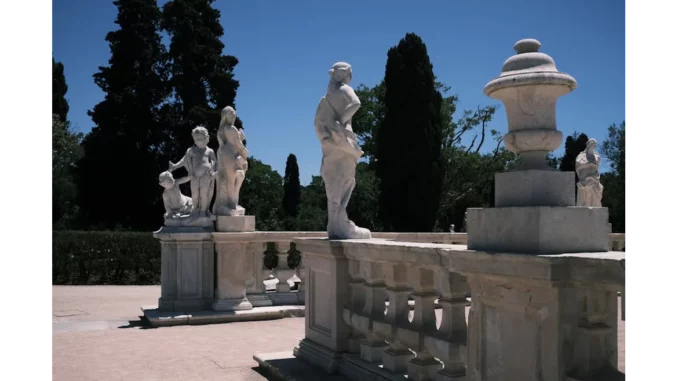
Envisioning Your European Garden Retreat: A Guide to Timeless Elegance
Turn your garden into your private retreat, enjoyable day or night complements of Elegancia.homes.
Imagine a garden that transports you to the verdant landscapes of Europe, where every corner whispers tales of charm and elegance. From the quaint courtyards of Provence to the majestic gardens of Versailles, these spaces embody a timeless allure that can be recreated in your own backyard. Embarking on this endeavour is not only rewarding but also entirely achievable. Here, we delve into the essential elements that define the quintessential European garden style and offer guidance on how to incorporate them into your own landscape.
1. Pea Gravel Pathways: The Whisper of Tradition
One cannot overlook the iconic pea gravel pathways that meander through European gardens, offering both rustic charm and practical functionality. As you stroll along these paths, the soft crunch underfoot evokes the leisurely ambles of a French countryside estate. To craft your own pathway, begin by outlining the course with garden stakes and string. Excavate the path to a depth of three inches, fill it with crushed stone for drainage, and top it with pea gravel. This straightforward addition will immediately enhance the aesthetic appeal of your garden.
2. Formal Hedges and Boxwoods: Sculpting Nature’s Architecture
The structured elegance of European gardens often finds expression through formal hedges and boxwoods. These verdant sculptures bring architectural interest, transforming garden spaces into well-defined ‘rooms’. Boxwoods, with their dense foliage and year-round greenery, are ideal for creating clean lines. Consider flanking pathways with these hedges or framing a central feature such as a fountain. Their timeless presence ensures your garden remains structured and elegant throughout the year.
3. Water Features and Fountains: The Symphony of Serenity
The gentle murmur of water is a signature element of European gardens, offering tranquility and a focal point for reflection. Whether a grand tiered fountain or a modest tabletop feature, incorporating water elevates the garden’s atmosphere. If space permits, install a classic stone fountain as a central masterpiece. For more compact spaces, a wall-mounted fountain can provide an equally soothing effect. Choose a design that harmonises with your garden’s style, allowing the soothing sounds of water to envelop your outdoor sanctuary.
4. Al Fresco Dining Spaces: Savoring the Outdoors
A European garden is incomplete without a dedicated space for al fresco dining. From intimate bistro sets on gravel patios to expansive dining areas under pergolas, outdoor dining is a cherished tradition. Position your dining ensemble to capture scenic garden views or nestle it among aromatic herbs like rosemary and lavender. Opt for wrought iron or weathered wood furniture, adorning it with cushions or linens in timeless patterns such as stripes or florals, to enhance the European ambience.
5. Incorporating Vintage Elements: A Touch of History
Infuse your garden with European charm by adding vintage elements that speak of history and character. Weathered planters, terracotta pots, and reclaimed ornaments can provide a sense of continuity with the past. Vintage furniture, like a wrought iron bench or an antique wooden table, can serve as captivating focal points. Blend these elements with new plantings to create a harmonious look that feels both timeless and inviting.
6. Choosing the Right Plants: Cultivating Elegance
Selecting the right plants is crucial in capturing the essence of a European garden. Embrace a palette of flowering shrubs, evergreen hedges, and climbers to weave layers of visual interest. Fragrant blooms such as lilacs and roses introduce both colour and scent, while evergreens offer structural stability. Incorporate fruit trees like figs or olives, not only for their aesthetic contribution but also for the delight of homegrown produce. Climbers such as wisteria or ivy can grace pergolas and walls, adding vertical intrigue and romance.
7. Embracing Naturalistic Planting: A Dance with Nature
While formal elements define European gardens, embracing a naturalistic approach invites the wild beauty of nature into your space. This style employs a mix of perennials, grasses, and bulbs to create a dynamic tapestry of colour and texture that evolves with the seasons. Plant drifts of lavender or salvia interspersed with ornamental grasses to add movement and contrast. The result is a garden that feels organic and alive, a reflection of nature’s own artistry.
Crafting a European-inspired garden goes beyond mere aesthetics; it is about creating a space that invites relaxation and enjoyment. By integrating elements like pea gravel pathways, formal hedges, water features, and vintage accents, you can transform your backyard into a personal retreat that echoes the timeless beauty of Europe. Whether you’re savouring a morning coffee in a cosy bistro nook or tending to your lush plantings, your garden becomes a cherished haven, mirroring both your personal style and the enduring allure of European landscapes.


Be the first to comment